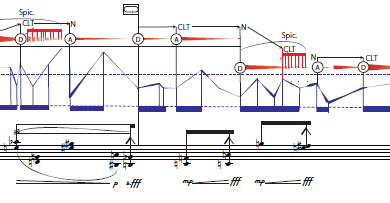Music student John Aulich published an article about his research in Issue 2 of our student research journal Fields . We caught up with him for a chat about his work and his experiences getting published.
In the summer of 2015, I was invited to prepare a piece I had written in the third year of my undergraduate studies for inclusion in the second volume of FIELDS. ‘ Power, agency, deference and difference: Examining the politics of composer–performer relationships in the wake of recent innovations ’ explored the notational praxes of three radically divergent composers to try and uncover the ways in which they might limit or encourage interpretative agency on the part of performers. The paper was one among a number of tentative early steps on a wider research trajectory concerned with the immediate political ramifications of particular pieces of music. In other words, to ask how a piece establishes hierarchies between performers, composers, and audiences at the moment of performance. For me, the emergent political microcosm that a performance inhabits is as integral to what music is or could be as more obvious specifics, such as notes, chords and rhythms.Read John’s article in Volume 2 of Fields
While further research has since led me to new positions not entirely congruent with the implications and conclusions of that particular paper, being invited to publish and continuously advised by experienced scholars throughout the process gave me the confidence to develop new lines of inquiry. It was an indication that I might be onto something; that somebody somewhere thought it a valuable contribution of potential interest to the wider academic world. Further, participating in Fields allowed me to join a community of colleagues in the same position, whose incredibly diverse research interests caused me to see much more fertile grounds for cross-pollination than I had thought possible, from sociology to biomedical science. To borrow an illustrative concept from the urban sociologist Richard Sennett, the boundaries between our specialisms became fluid sites for the exchange and transformation of ideas: bustling hedgerows as opposed to concrete walls. Such was the impact of this realization that its resonances carried through my master’s research and into the heart of my current interests as a practising composer.
Inspired by the broadening sphere of influence on my creative world, my master’s research sought to turn the gaze of political analysis to my own work. By casting out the critical theory that strongly informed the paper published in FIELDS, I was able to reimagine musical processes and concepts as analogous with aspects of the material world, using post-structuralist materialist philosophy as a theoretical basis. I reimagined the score, for example, as a biological cell-like space with its own agency: it could both absorb and react to a specific performer’s energies, and resist them. To borrow a Tim Ingold idea, rather than read the score, a performer would instead correspond with it. In Condensation (Strike Work) (recording) , the music can only take form through an exploration of possible speeds by a specific performer. Like Manuel DeLanda’s Deleuzean metallurgist, a performer cannot impose the final form so much as tease it out.Illustration 1: Condensation (Strike Work) (2015). The speed indicator line on the left hand side of each staff is indicates the pace of the music relative to the fastest and slowest speeds a particular performer could possibly achieve.
Where I had previously imagined freedom to be the degree to which a performer can exercise their interpretative will uninhibited, I now imagine it to be more akin to the potential for new possibilities to emerge from this kind of correspondence. For Πολυτροπος [Polytropos] (recording), a later piece which I developed with the bass clarinetist and improviser, James Wood, this notion of correspondence took a more qualitative form in what I called the ‘flow rate’ line. To quote from the performance notes, ‘When the line is at its thinnest, performers should dwell in the material, pay more attention to detail, and take as much time as is necessary to execute the particulars as given. When the line is at its thickest, performers should hack through the material, allow for a high degree of inexactitude, and move faster.’Since completing my master’s degree, I’ve also explored the notion of correspondence with new technology. In an as-yet-untitled piece for fellow composer and violist Adam Sangster, the performer works with a computer algorithm that tends towards certain behaviours, but nonetheless reacts to his sounds in unpredictable ways. It has an agency of its own that he can try to subjugate, and he has an agency that it can also act to undermine by forcing him to switch between one of two staffs (see left).

In at least one respect since FIELDS, I’ve come full circle; a section of my FIELDS paper explored the implications of confusing cueing systems in some works by the composer Christian Wolf. For my first large-scale ensemble piece since participating, the composition of which is ongoing, I have developed a similarly confusion-inducing cueing system of my own. For now, the kinds of correspondence it might illicit among the players remains to be seen, but one thing is certain: I have no idea what I would be doing if it weren’t for FIELDS.
Back to News List
